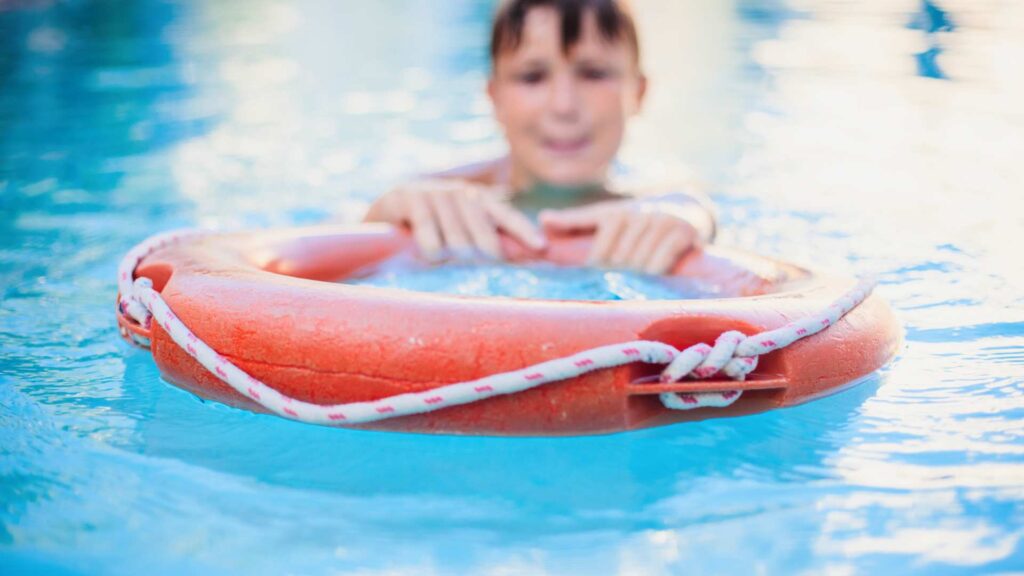Table of Contents
What are the risks for individuals with autism in the water?
There’s nothing like celebrating summer at the beach, in the pool with friends, or with different water activities. But this summer and vacation fun should be accompanied by water safety, especially for children diagnosed with autism spectrum disorder (ASD) who exhibit sensory sensitivities and navigate the world differently.
May is National Water Safety Month, a time dedicated to raising awareness about preventing water-related accidents. This initiative becomes even more critical when considering the alarming statistics. Between 2020 and 2022, the CDC reported an average of over 4,500 drowning deaths annually. Moreover, drowning remains the leading cause of death for children aged 1 to 4 years.
In this blog by ABA Centers of Delaware, we explore why water safety is particularly important for children on the spectrum, the unique challenges they may face around water, and how families can implement safe swimming strategies to prevent accidents—and, ultimately, save lives.
Understanding Water Risks for Children with Autism

The statistics regarding autism and drowning risk paint an alarming picture. According to the National Autism Association, children with autism are 160 times more likely to die from drowning compared to their neurotypical peers. This data makes accidental drowning the leading cause of death for children with autism who elope from safe environments.
What makes these numbers even more concerning is that nearly half (49%) of children with autism attempt to wander or elope from safe environments at some point—a rate almost four times higher than their unaffected siblings. This combination of wandering tendencies and water attraction creates a potentially dangerous situation that demands our attention and proactive measures.
Research published in Injury Epidemiology found that most fatal drownings occurred in ponds (52.2%), rivers (13%), and lakes (13%) that were close to the victim’s home, and wandering was the precipitating factor in 73.9% of cases.
Why Children With Autism Are Especially Vulnerable Around Water
To develop effective water safety strategies, it’s essential first to understand the unique challenges that children with autism face around water. Some of the most common include:
Sensory Appeal of Water
Water is an attraction for individuals with autism. The visual stimulation of rippling water and the tactile sensation of submersion can all be particularly appealing to children who seek sensory input.
Limited Danger Awareness
Children with autism often struggle to recognize hazardous situations. They may not understand that deep water poses a drowning risk or that strong currents can quickly overwhelm even strong swimmers. This perception reduced danger awareness, which means they might walk directly into potentially life-threatening situations without hesitation.
Communication Difficulties
Some children with autism have limited verbal abilities, making it difficult or impossible for them to call for help if they are in distress. Even children who typically communicate well may struggle to express their needs in unfamiliar or stressful situations, like being in water.
Elopement Behaviors
As previously mentioned, elopement or wandering is common among children with autism. The National Autism Association reports that in a six-year study of mortality and risk associated with autism wandering, accidental drowning accounted for 71% of related deaths. Children may slip away unnoticed, often heading directly toward water sources.
Coordination Challenges
Some children with autism experience difficulty in motor coordination, which can impact their ability to swim effectively. These physical challenges can make it harder for them to stay afloat or navigate through water safely.
National Water Safety Month: Raising Awareness
National Water Safety Month, held each May, serves as a potent reminder to prioritize water education and prevention strategies for all families. Launched initially as National Water Safety Week in 2003, it evolved into a month-long awareness campaign in 2007, when swimming activity typically increases across the U.S.
Organizations like the American Red Cross, the National Drowning Prevention Alliance, and the Pool & Hot Tub Alliance now support the campaign.

This initiative not only highlights general swimming dangers but emphasizes the importance of inclusive swim programs, supervision, and policy changes to protect the most vulnerable populations, especially children with autism.
Building Water Safety Habits: What Families Can Do
Developing a thorough water safety plan for a child with autism involves careful consideration of their individual needs, challenges, and abilities. Parents navigating this journey of neurodivergence discover valuable insights and new strategies to support their children in everyday life. Let’s find out strategies for a safe swimming experience!
Early Swim Instruction
One of the most critical steps in promoting water safety is providing swim lessons specifically designed for children with autism. Look for instructors who have experience working with neurodivergent children and can adapt their teaching methods to accommodate sensory sensitivities, communication differences, and attention challenges.
Constant, Vigilant Supervision
When it comes to water safety for children with autism, attentive supervision is simply no substitute. The “Phones Down, Eyes Up” campaign highlights the critical importance of undistracted supervision around water. Even momentary distractions—checking a text message, answering a phone call, or chatting with another adult—can provide enough time for a child to slip underwater or wander away.
Consider implementing a designated “water watcher” system when around water, where one adult is specifically assigned the responsibility of watching the children without any other distractions.
Environmental Safeguards
Creating physical barriers between children and water sources is an essential safety measure, especially for families of children who tend to wander. Install four-sided fencing (at least 4 feet high) with self-closing, self-latching gates around home pools. Consider additional layers of protection like pool alarms, safety covers, and door alarms on access points to the yard or pool area.
For families living near natural water bodies like ponds or lakes, extra precautions may be necessary, such as door alarms, window locks, and secured boundary fencing.
Visual Supports and Social Stories
Visual support is an essential communication tool in autism, as some individuals with ASD process better visual information. Create simple, clear visual rules about water safety using pictures and minimal text. Social stories—personalized short stories that describe social situations and appropriate responses—can also help children understand water safety expectations.
How ABA Therapy Supports Water Safety Awareness

Children with autism benefit greatly from structured and individualized instruction, especially when it comes to learning safety routines. At ABA Centers of Delaware, we offer personalized ABA therapy programs that include teaching essential life skills like water safety, following rules, and responding to environmental cues.
Our therapists can work with your child to build the foundation for understanding danger, staying within boundaries, and improving communication, which can contribute to safer experiences around water.
Making Water Safety a Year-round Priority
While National Water Safety Month in May provides a valuable opportunity to focus on drowning prevention, water safety requires year-round vigilance, especially for families of children with autism.
At ABA Centers of Delaware, we know that the safety of our loved ones is always a priority. That’s why our ABA therapy programs include learning self-care skills and abilities that help improve behaviors that can put children at risk, such as eloping.
To start ABA therapy, contact one of our experts at (844) 855-8517 or contact us online. Find out how our approaches can support your child’s safety, independence, and quality of life.








